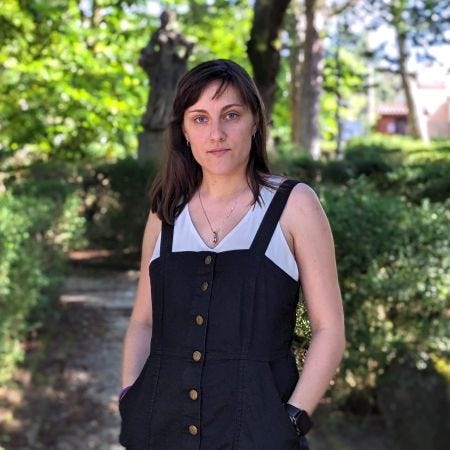# Vestibular Hair Cells: The Unsung Heroes of Balance and Movement
Written on
Understanding the Function of Ears Beyond Hearing
When we typically think of ears, hearing is often the first function that comes to mind. However, there's much more to ear cells than just sound detection. This article will delve into the role of vestibular hair cells, which are found in the inner ear. These specialized cells are part of a complex vestibular system that includes the otolith organs known as the utricle and saccule, along with three semicircular canals. Although this intricate system can fit comfortably on the tip of a pencil, it is vital for maintaining our body's balance. It helps us align ourselves with gravity, facilitating actions like walking, running, and dancing (1). Interestingly, there are only about 16,000 vestibular hair cells compared to approximately 3.5 million auditory hair cells, yet their role in our everyday lives is just as significant (2).
Interpreting Movement: The Connection Between the Brain and Hair Cells
Vestibular hair cells act as mechanoreceptors that specifically respond to mechanical energy, such as movement (3). They receive their name from the hair-like structures called stereocilia that extend from their surface (4). When we move our heads, these stereocilia shift, triggering the opening of ion channels at their tips. The influx of ions into the hair cells alters the electrical charge, creating an electrical signal that is sent to the vestibular nerve. The brain then interprets these signals, converting them into useful information about our body's position and motion, which is crucial for maintaining balance and spatial awareness (5, 6). While the semicircular canals monitor rotational movements, the otolith organs are responsible for detecting linear movements and the effects of gravity (7).
The Remarkable Sensitivity of Hair Cells
The vestibular system showcases impressive sensitivity, capable of detecting movements smaller than an atom's diameter. These cells are constantly active, even during sleep. While their primary job is to help maintain balance, vestibular hair cells also play a key role in coordinating eye movements through the vestibulo-ocular reflex. This reflex enables us to focus on objects, regardless of head movement, allowing us to read while jostling on a bus or shaking our heads (8).
The Fragility of Vestibular Hair Cells
Unlike many other cell types in our body that continuously divide and replace themselves, the number of vestibular hair cells remains constant throughout our lives. As we age, these cells deteriorate and can only regenerate to a limited extent when damaged (9). A significant loss of these cells can lead to symptoms such as nausea, imbalance, dizziness, and even severe disability (10). Alarmingly, vestibular impairments affect a considerable portion of the population, with estimates indicating that 35% of Americans over the age of 40 experience such issues, and this number escalates with age (11). However, there is potential for regeneration. In rodent studies, specific type II hair cells have shown the ability to regenerate and reconnect, hinting at possibilities for restoring vestibular function (12–14). This regenerative process is the subject of extensive research across various laboratories worldwide.
Recognizing Key Research Labs
Several research institutions are making strides in this area, including:
References
- Day BL, Fitzpatrick RC. The vestibular system. Current biology. 2005;15(15):R583-R6.
- Zhang LW, Cang XH, Chen Y, Guan MX. In vitro culture of mammalian inner ear hair cells. Journal of Zhejiang University Science B. 2019;20(2):170–9.
- Gillespie PG, Müller U. Mechanotransduction by hair cells: models, molecules, and mechanisms. Cell. 2009;139(1):33–44.
- Khan S, Chang R. Anatomy of the vestibular system: a review. NeuroRehabilitation. 2013;32(3):437–43.
- Colclasure JC, Holt JR. Transduction and adaptation in sensory hair cells of the mammalian vestibular system. Gravit Space Biol Bull. 2003;16(2):61–70.
- Eatock RA, Songer JE. Vestibular hair cells and afferents: two channels for head motion signals. Annual review of neuroscience. 2011;34:501–34.
- Haggerty SE, King WM. The Interaction of Pre-programmed Eye Movements With the Vestibulo-Ocular Reflex. Frontiers in Systems Neuroscience. 2018;12.
- Huang Y, Mao H, Chen Y. Regeneration of Hair Cells in the Human Vestibular System. Frontiers in Molecular Neuroscience. 2022;15.
- Brandt T, Dieterich M. The dizzy patient: don’t forget disorders of the central vestibular system. Nature Reviews Neurology. 2017;13(6):352–62.
- Burns JC, Stone JS. Development and regeneration of vestibular hair cells in mammals. Seminars in Cell & Developmental Biology. 2017;65:96–105.
- Kawamoto K, Izumikawa M, Beyer LA, Atkin GM, Raphael Y. Spontaneous hair cell regeneration in the mouse utricle following gentamicin ototoxicity. Hearing research. 2009;247(1):17–26.
- Lin V, Golub JS, Nguyen TB, Hume CR, Oesterle EC, Stone JS. Inhibition of Notch activity promotes nonmitotic regeneration of hair cells in the adult mouse utricles. The Journal of neuroscience: the official journal of the Society for Neuroscience. 2011;31(43):15329–39.
- Slowik AD, Bermingham-McDonogh O. Hair cell generation by notch inhibition in the adult mammalian cristae. Journal of the Association for Research in Otolaryngology : JARO. 2013;14(6):813–28.
About the Author

DR. AGA SZMITKOWSKA
Content Editor, The League of Extraordinary Celltypes, Sci-Illustrate Stories
Dr. Szmitkowska earned her Ph.D. in Biochemistry from CEITEC/Masaryk University in the Czech Republic. She is dedicated to public speaking and science communication and has worked as a content coordinator in lifestyle and longevity sectors.
About the Artist

NELLY AGHEKYAN
Contributing Artist, The League of Extraordinary Celltypes, Sci-Illustrate Stories
Nelly Aghekyan holds degrees in Architecture and has transitioned into illustration, focusing on children's book art. Currently based in Italy, she collaborates with various clients as a freelance artist.
About the Animator

DR. EMANUELE PETRETTO
Animator, The League of Extraordinary Celltypes, Sci-Illustrate Stories
Dr. Petretto completed his Ph.D. in Biochemistry, specializing in nanoscopic interactions. He is now focused on merging art and science through data visualization and motion design.
About the Series
The League of Extraordinary Celltypes is an engaging series presented by the team at Sci-Illustrate and Endosymbiont, exploring the fascinating cell types that contribute to the functioning of our bodies.